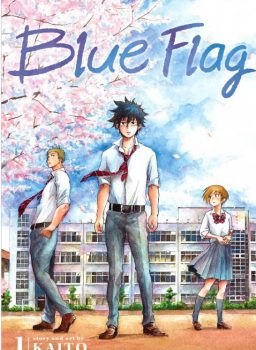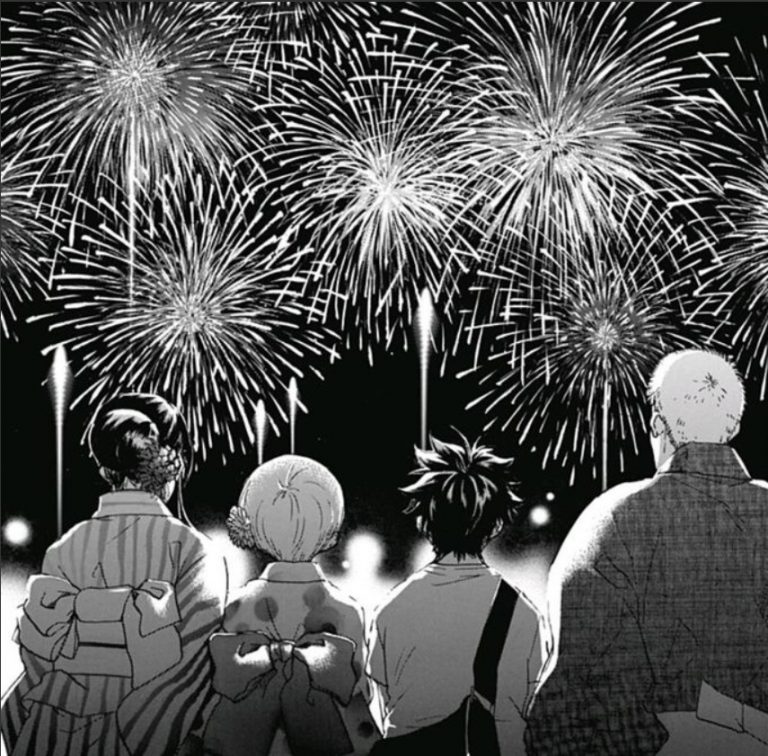 Title: Blue Flag (Ao no Flag / 青のフラッグ)
Title: Blue Flag (Ao no Flag / 青のフラッグ)
Author: KAITO (Story & Art)
Genres: School Life, Slice of Life, Romance, Comedy, Drama, LGBTQ+, Shoujo
Rating: Teen
Published: 2017 – 2020
Volumes: 8* [Completed]
Japanese Publisher: Shounen Jump+
English Publisher: Viz Media
Available to Purchase in English?: Yes (Indigo / Amazon / Barnes & Noble)
This Review Is Based On: The entire series
*Note: There are 8 Japanese tankōbon, but according to Indigo’s website, there are only 7 volumes in English.
Synopsis: An unexpected love quadrangle with a dash of unrequited love as two classmates, a boy and a girl, begin to fall for each other when each of their best friends have already fallen for them.
Love is already hard enough, but it becomes an unnavigable maze for unassuming high school student Taichi Ichinose and his shy classmate Futaba Kuze when they begin to fall for each other after their same-sex best friends have already fallen for them.
For some reason, Taichi Ichinose just can’t stand Futaba Kuze. But at the start of his third year in high school, he finds himself in the same homeroom as her, along with his childhood friend Toma Mita, a star athlete. But one day, Futaba opens up to Taichi and admits she has a crush on Toma. She then asks for his help in confessing to him! There’s just one problem—Toma seems to already have a secret crush on someone else. (Amazon)
If there’s one thing I hate about romantic comedies or romantic dramas it’s love triangles which are done stupidly. Especially when they include pointless drama for the sake of dragging out a weak plot. However from the moment I read the synopsis for Blue Flag, I had the feeling I’d discovered a very special title.
As you can read in the synopsis, Blue Flag has not just a love triangle but a love quadrangle. There’s lots of feelings and hormones flying all over the place and there’s unrequited love galore. As, well, to be expected with a love quadrangle. (Hey, isn’t a “love quadrangle” really just a square?)
So you the reader know right from the first page that there is going to be a main opposite-sex couple, and you also know that there are two unrequited same-sex relationships which also exist, but are not acknowledged. This creates a tension of sort, a will-they-or-won’t-they-say-something situation which keeps the reader on the edge of their seat. Surprise fact: there are not just the three relationships mentioned in the synopsis but a few other unrequited relationships which emerge later too. Lots of relationship drama to keep the reader intrigued. ;D
As the plot progresses and our cast go through their final months of school while looking forward to their futures, the stakes continually get higher and higher. Do Toma and Masumi (Futaba’s best friend) say something about their hidden feelings and risk losing their precious friendships? Is it ok to not go to the same post-secondary institution as your partner if you’re choosing to put your education first?
Blue Flag is narrated throughout from Taichi’s perspective, with the final chapter being shown from Toma’s point of view. The latter took a little adjusting to as the entire series is told from a third person perspective, typical for most manga. I had to use the process of elimination to figure out whose eyes I was seeing through. ^^;; Time-wise, Blue Flag takes place in our cast’s final year of high school, and there are two time skips in the final chapter.
What I liked a lot and appreciated about Blue Flag was that all the same-sex relationships are treated equal to heterosexual relationships; no one is singled out as being “different” or lesser than. Even in the synopsis, you can read the two same-sex relationships are mentioned immediately and treated equally. Furthermore the queer characters in Blue Flag still struggle with their romantic feelings, with guilt, shame, and regret… but so do the heterosexual characters. Heavier topics like abuse and homophobia are eventually confronted later in the series, and every once in awhile a character will get into a fight with someone else and make a loud social commentary disguised as a speech. (Those were fun to read.)
I love KAITO-san’s artwork, especially how he chibi’fied some of his characters. Namely Taichi Ichinose. He’s about Futaba’s height but with his sometimes childish personality, when he got upset or emotional he just ended up looking like a cranky child having a tantrum. xD Futaba has a much more mild and passive personality so her shortness just makes her look cute.
I really, really enjoyed Blue Flag! As I continued reading I had a horrible suspicion that the series was going to end a particular way; thankfully I was wrong. There was a twist at the end that I wasn’t expecting, but for me the ending felt true to the characters and while I was a little sad that part of the ending wasn’t what I had been hoping for, seeing other things come into being felt like a genuine finale. There was also a page in the final chapter which showed what most of Blue Flag‘s cast were doing in life at that point in time, and I thought that was a really awesome way of touching base with all the characters who couldn’t be included in the final chapter.
Do I Recommend This Title to Others? Yes! The characters have real depth, feelings, and relationships with one another. Blue Flag gently eases into some of its darker topics but does not shy away from confronting stigma and heartbreak. I laughed, I giggled, and I cried while reading Blue Flag. Definitely one of my new favourite titles!
Final Score: 10/10



